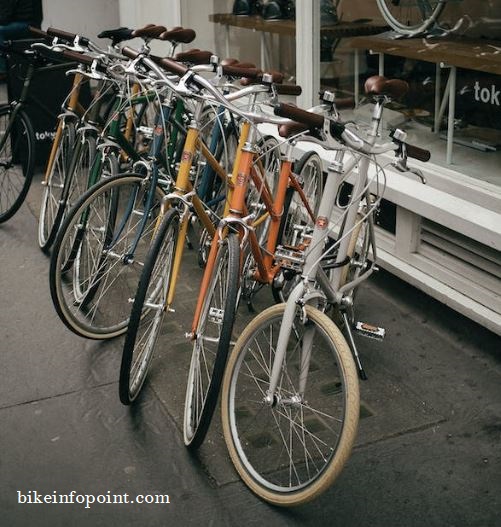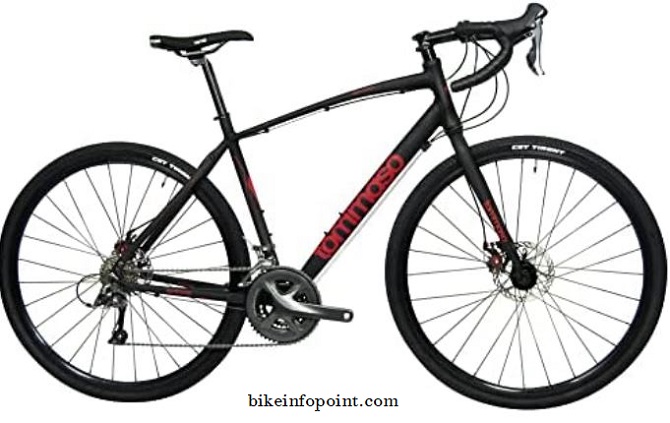
What is a Road Bike
A road bike is a type of bicycle that is designed for riding on paved roads. They are typically lightweight and aerodynamic, with narrow tires and drop handlebars. These features make road bikes ideal for long distance riding, racing and general fitness.
Road bikes have a lightweight frame, typically made of carbon fiber, aluminum or titanium. This material choice allows for a strong and durable bike that is easy to maneuver. The geometry of a road bike is also designed to be more aggressive, with a more forward riding position. which allows for better power transfer and increased speed.
One of the most distinctive features of a road bike is the drop handlebars. These handlebars allow for multiple hand positions, which can help reduce fatigue during long rides. It also provides a more aerodynamic riding position, which can help to increase speed.
The tires on a road bike are typically narrow and smooth, with a width of 23-25mm. This design allows for less rolling resistance and improved speed on paved roads. They also have a high pressure rating, which helps to reduce the risk of punctures.
Road bikes usually have multiple gears, typically between 14-30. This allows riders to easily adjust their speed and power output to suit the terrain. The gear shifting is usually done through the use of brake levers, which are located on the drop handlebars.
Table of Contents
ToggleCharacteristics of a Road Bike

A. Lightweight frame: A road bike’s frame is typically made of carbon fiber, aluminum, or titanium. These materials are chosen for their strength, durability, and low weight. This makes the bike easy to maneuver and accelerate, which is important for racing and long distance riding. A lightweight frame also helps to reduce the overall weight of the bike, making it easier to carry and transport.
B. Drop handlebars: Drop handlebars are one of the most distinctive features of a road bike. These handlebars allow for multiple hand positions, which can help reduce fatigue during long rides. The handlebars also provide a more aerodynamic riding position, which can help to increase speed. The brake levers are typically located on the drop handlebars. Which allows for easy gear shifting while maintaining a steady grip on the handlebars.
The drop handlebars are typically made of aluminum or carbon fiber, which are both lightweight and durable materials. They come in different shapes and sizes, and some are designed specifically for racing, while others are more comfortable for long distance riding.
C. Narrow Tires: Road bikes typically have narrow tires, with a width of 23-25mm. This design allows for less rolling resistance and improved speed on paved roads. The narrow tires also help to reduce the weight of the bike, making it more efficient for long-distance riding and racing.
The tires used on road bikes are typically made of a lightweight and durable rubber compound. They also have a high pressure rating, which helps to reduce the risk of punctures.
The narrow tires also have a low profile tread pattern, which helps to reduce the resistance of the tires against the ground. This improves the bike’s speed and efficiency on paved roads.
D. Multiple Gears: Road bikes typically have multiple gears, typically between 14-30, which allows riders to easily adjust their speed and power output to suit the terrain. This can be especially useful for riding in hilly areas or for maintaining a steady pace during a race. The gear shifting is usually done through the use of brake levers, which are located on the drop handlebars. This allows the rider to easily shift gears without having to take their hands off the handlebars.
The gears on a road bike are typically controlled by a system called a derailleur. The derailleur is a mechanism that moves the chain between the different gears on the bike. The derailleur is controlled by the shifters, which are located on the handlebars. The derailleur system allows for smooth and precise shifting between gears, making it easy to find the right gear for any situation.
Types of Road Bikes

A. Racing bikes: Racing bikes are also known as road racing bikes. These bikes are designed specifically for competitive road racing. It has a lightweight frame, typically made of carbon fiber, and is designed to be as aerodynamic as possible. Racing bikes have a more aggressive geometry than other road bikes, with a lower handlebar position and a steeper seat tube angle. Which allows for maximum power transfer and speed. They also have a high gear ratio, which allows for efficient pedaling at high speeds.
B. Endurance bikes: Endurance bikes are also known as sportive bikes. These bikes are designed for longer rides and endurance events. It has a more relaxed geometry than racing bikes, which allows for a more comfortable riding position over extended periods of time. It also has a slightly heavier frame, which provides added stability and comfort. Endurance bikes often have a slightly wider tire than racing bikes, which provides a smoother ride and improved traction.
C. Touring bikes: Touring bikes are designed for long distance touring and multi day trips. Touring bikes have a sturdy and durable frame, typically made of steel or titanium. Which can withstand the added weight of touring gear. Touring bikes also have a more relaxed geometry than racing bikes, which allows for a comfortable riding position over extended periods of time. These bikes also have a wide range of gears, which allows for easy climbing of steep hills and efficient pedaling on flat roads. Touring bikes also often have features such as additional braze-on for pannier racks and other touring gear.

D. Gravel Bikes: Gravel bikes are a relatively new category of road bikes that are designed for riding on unpaved roads, such as gravel paths, dirt roads, and even some singletrack trails. These bikes have a sturdy frame, typically made of steel or aluminum, which can handle the rough terrain and additional weight of gear. It also has a more relaxed geometry than racing bikes, which allows for a more comfortable riding position over extended periods of time.
Gravel bikes have wider tires than traditional road bikes, with a width of 30-45mm. These bikes also usually have a wider gear range than traditional road bikes. Which allows for easy climbing of steep hills and efficient pedaling on flat roads.
How to Choose a Road Bike
A. Consider your riding style and goals: When choosing a road bike, it is important to consider your riding style and goals. If you plan to use your road bike for racing, a lightweight and aerodynamic bike with a more aggressive geometry will likely be the best choice. If you plan to use your road bike for long distance rides, an endurance bike with a more relaxed geometry will likely be more comfortable. If you plan to use your road bike for touring, a touring bike with a sturdy and durable frame and a wide range of gear will be a good choice.
B. Evaluate the fit and geometry of the bike: When choosing a road bike, it is also important to evaluate the fit and geometry of the bike. The bike should be the right size for you, and the geometry should be comfortable for your riding style. The bike should also be properly adjusted to your body size and riding style. This ensures that you’ll be comfortable and efficient while riding.
C. Look at the components and materials used: When choosing a road bike, it is also important to look at the components and materials used. The components, such as the gears, brakes and wheels, should also be of high quality and be appropriate for your riding style and goals.
Maintaining and Upgrading a Road Bike
Regular cleaning and inspections are important to keep your road bike in good working condition. It’s important to inspect your bike before every ride, check for loose or damaged parts and make sure that the tires are properly inflated.
Proper tire inflation is important for maintaining the performance and safety of your road bike. Tires that are under inflated can cause increased rolling resistance and make the bike harder to ride. Tires that are over inflated can cause a loss of traction and increase the risk of punctures. It’s also important to adjust the gears properly, this ensures that the bike shifts smoothly and that the gears are not damaged.
Maintaining and upgrading a road bike is important to keep it in good working condition and ensure that it performs at its best.
A road bike is a type of bicycle designed for riding on paved roads. Whether you are a competitive cyclist or a casual rider, a road bike can be an excellent choice for your next two-wheeled adventure.


